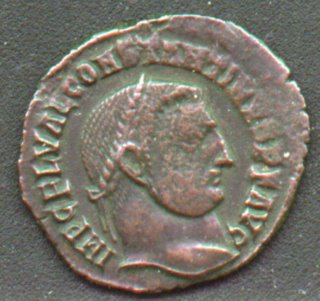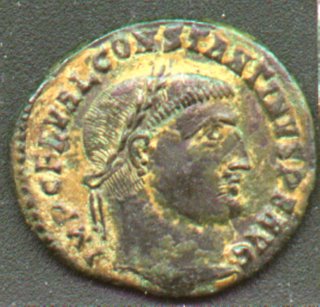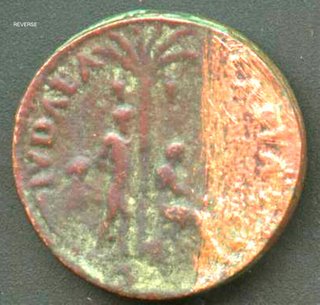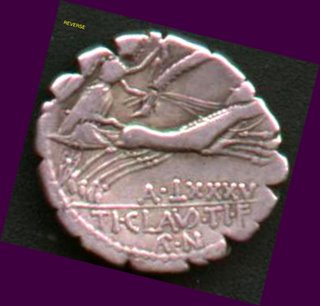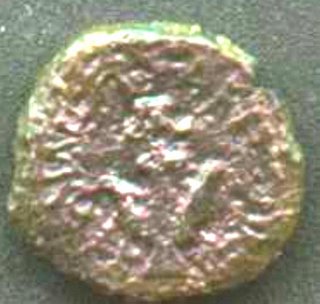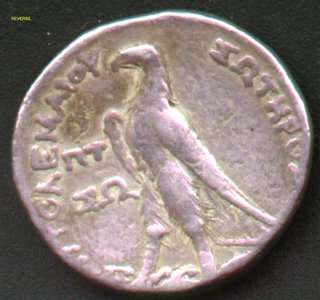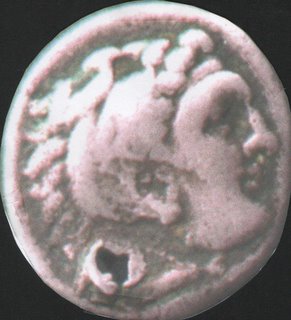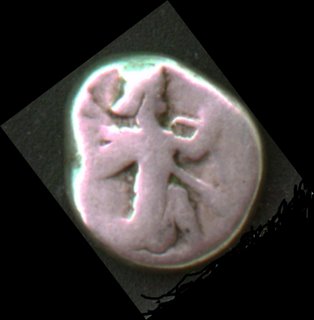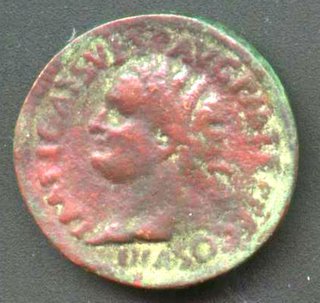THE COINS IN RON’S COLLECTION
THE TOP 20 COINS ARE SHOWN IN BOLD Note: The Top 20 are not necessarily the best coins in my collection, but have been chosen as being representative of the collection as a whole.
The reference number shown at the end of a line refers to a coin held in the collection.
The first 3 digits relate to the original RG database.
The next 4 to 5 digits refer to the Seaby’s Catalogue number.
The last number relates to the folio number in the collection.
As an example the coin of Darius I has a reference number of 253/3428/1
This coin is therefore catalogued as follows:
1. It is the 253rd coin purchased
2. It is to be found under Seaby’s catalogue number 3428
(Greek Coins & their values, David R. Sear)
It is held in the collection under Folio 1
(The first coin on display because it is the earliest coin)
BC 536 The edict of Cyrus,Jews began rebuilding the Temple in Jerusalem
BC 529-522 Cambyses King of Persia
BC 522 Darius divides Persian Empire into 20 Satraps (provinces)
BC 510-486 * Darius I,The Great (Old Test.EZRA Chap6.) 253/3428/1BC 516 Rebuilding of Temple, consecration BC 515.
BC 510 Rome declared a Republic,last King,Tarquin the Proud
expelled
BC 499 Ionian Greeks revolt against Persian rule.
BC 494 Rome:Office of Tribune created to protect rights of plebes.
Ionian revolt collapses.
BC 490 Darius launches attack on mainland Persia starting the
Persian Wars. Persian armies defeated by Greeks at Marathon
BC 485 Death of Darius I,decline of Persia comences
BC 485-465 Persian king Xerxes I succeeds Darius
BC 483 Rich silver strike at Mount Larium provides Athens with
funds to expand its fleet.
BC 480 Persians defeated by Greeks at Salamine & Plataea (BC 479)
Acropolis is destroyed by the Persians.
BC 479 CLASSICAL PERIOD OF GREEK COINAGE
BC 477 Commencement of Athenian ascendency
BC 474 * City States, Syracuse in Sicily 229/929/2
BC 464-424 Persian king Artaxerxes
BC 445 War between Athens & Sparta ends with 30 year truce
The prophet Malachi; Nehemiah rebuilds walls of Jerusalem.
The Evolving Bible A Theoretical timeline
BC 444-397 Jewish revival of Judea with Nehemiah’s arrival in Jerusalem.
Redaction of Torah climaxes with Ezra reading out the completed text in Temple courtyard for the first time.
BC 440 Ezra (The Scribe) & Nechemia re-dedicate Second Temple
BC 431 Peloponnesian war between Athens & Sparta begins
BC 425 * City States,Gela in Sicily 149/1095/3
* City States, Akragas in Sicily 195/?/4
BC 415 War renewed between Athens & Sparta
BC 402 End of Peloponnesian War
BC 400 * City of Carthage in North Africa 159/6444/5
* City of Carthage 246/6520/?
* City states, Syracuse in Sicily 208/1193/6
BC 399 Socrates tried and condemned to death commits
BC 395 Coalition between Athens,Thebes,Corinth & Argos
against the Spartans
BC 393 * City of Athens 202/2537/7BC 390 Gauls from N.Italy capture Rome,sack city & withdraw
BC 385 Plato starts teaching in Athens.
BC 375 * City of Carthage in North Africa 209/?/8
* City of Carthage 223/6526/9
* City of Kalymna 224/4982/10
BC 359-362 * Philip II of Macedon 214/6698/11
BC 350 * City of Kardia (Thrace) 242/1598/12
* City of Gargara 239/4089/13
BC 343 Aristotle becomes tutor to young Alexander of Macedon.
BC 338 Romans begin to use coins
BC 336 Philip II assasinated at Aegae 189/6730
BC 334-323 Alexander III (The Great)
* Alexander the Great succeeds Philip II 189/6730/16 * Alexander the Great 107/?/14
* Alexander the Great 108/?/15
* Alexander the Great 238/6739/17
BC 333 Persian Empire defeated by Alexander, all Near East
comes under influence of Hellinism.
BC 332-63 The Hellenistic & Hasmonean Periods in Israel
BC 332 Alexander destroyed Tyre,Egypt & Jerusalem submit to
Greece
The Evolving Bible A Theoretical timeline
BC 332 Alexander the Great conquers Jerusalem. Helenist period begins
during which Bible is translated into Greek (Septuagint)
BC 331 Battle of Arbeles and the fall of the Persian empire.
BC 323 Death of Alexander, period of struggle for supremacy
by his Generals. Ptolemaic Dynasty begins with Ptolemy I
becoming King of Egypt, the Seleukid Dynasty with
Seleuchus I in Syria & Messopotamia.
THE SELEUCIDS
Seleucids, dynasty of Macedonian kings that reigned in the Middle East from the 4th to the 1st century BC. Established when the empire of Alexander the Great was partitioned among his followers, the Seleucid kingdom originally extended eastwards from Asia Minor into what is now Pakistan. The most important Seleucid kings were Seleucus I, Antiochus I, Antiochus II, Seleucus II, Antiochus III, and Antiochus IV, whose reigns spanned the period between 312 BC and 163 BC with brief interruptions.
The Seleucid kingdom had two capitals: Antioch in Syria (now Antakya, Turkey) and Seleucia on the Tigris in Mesopotamia. The Seleucids were Greeks in language and culture, and they encouraged Greek colonists to settle in their domains. Nevertheless, in their autocratic rule they followed the example of their Syrian, Mesopotamian, and Persian predecessors. Beginning with Antiochus II, they were worshipped as gods. They were frequently involved in wars with the Ptolemies, a Macedonian dynasty that had established itself in Egypt.
After 250 BC the Seleucids gradually lost control of the lands east of the Euphrates River and were expelled from Asia Minor. Syria, the last remaining part of their kingdom, was annexed by Rome in 64 BC.
Seleucus I, called Nicator (Greek, “the conqueror”) (c. 358-280 BC), king of Syria (301-280 BC). The founder of the Seleucid dynasty, he was a Macedonian general who served under Alexander the Great, and in the second partition of Alexander's empire in 321 BC was made satrap (governor) of Babylon, becoming king of Babylonia in 312 BC. In 302 BC he joined the confederacy against Macedonia and in 301, upon the defeat and death of King Antigonus I of Macedonia, obtained the largest share of the spoils, including the whole of Syria and a great part of Asia Minor. He built numerous cities, including Antioch and several named after him, including Seleucia on the Tigris, Seleucia Pieria, and Seleucia Tracheotis. He proclaimed himself king of Macedonia but was assassinated soon after.
Seleucus II, called Callinicus (c. 265-226 BC), ruler (247-226 BC) of the Seleucid kingdom, the son of Antiochus II Theos. Seleucus II was unable to prevent Ptolemy III of Egypt from invading Syria and Mesopotamia during the Third Syrian War (246-241 BC). He allowed the Bactrians and Parthians to establish their independence in the east and lost his possessions in Asia Minor to his brother Antiochus Hierax . 7
THE PTOLEMYS
Ptolemy 1 d. 283BC. Egyptian king (305-285BC). A Macedonian, Ptolemy was one of
Alexander the Great's most successful generals. After Alexander's death (323 Bc), he
quarrelled with other generals (Diadochi, q.v.) over the empire's division, and became satrap
of Egypt. He engaged in warfare to protect and expand his holdings. Though defeated by
Demetrius in a battle at Salamis (306BC), he named himself Egypt's king and soter (savior)
the following year. He established Alexandria as a centre of culture and commerce, founded its
famed library, planned Egypt's government, and began the Ptolemaic dynasty. He abdicated in
favour of his son (285BC).
Ptolemy 11 (Philadelphus, Ptolemy II ( c308-246 BC.) Ancient Egyptian king (285-246 BC)
successor to his father Ptolemy 1. He helped make Alexandria the centre of Hellenistic culture,
built the city's famous museum, and commissioned the translation of the Hebrew Bible into the
Greek Septuagint.
Ptolemy 111 (Euergetes, Ptolemy 111) d. 222? BC. Ancient Egyptian king (246-222 BC)
successor to his father, Ptolemy 11. He reunited Egypt and Cyrenaica, warred with Syria,
and established Egyptian naval supremacy in the eastern Mediterianean.
Ptolemy IV (Philopater, Ptolemy IV)d. 205 BC. Ancient Egyptian king (221-205 BC) successor
to his father, Ptolemy 111. Though he defeated the Seleucids in Syria (217BC), the loss of Syrian
lands rebellions and internal began was a debauched man who rule and had many relatives
murdered.
Ptolemy V (Epiphanes, Ptolemy V, Ancient Egyptian king (205-18) his father Ptolemy IV.
During his reign Levantine possessions were lost but peace was finally concluded with his marriage
to Cleopatra, daughter of Syrian King Antiochus 111. T he Rosetta Stone concerns his accession to
the throne.
Ptolemy VI (Philometer, Ptolemy V1, Ancient Egyptian king (180-1) his father, Ptolemy V.
Obliged to share power with his brother, later Ptolemy V11 he helped bring about the first
Intervention of Rome in Egyptian affairs.
Ptolemy VII (Physcon, Ptolemy V11, Ancient Egyptian king (145-116?). Usurping the throne
from his brother, he ruled with great cruelty, provoking revolts. He drove the scholars
from Alexandria.
Ptolemy VIII (Lathyrus, Ptolemy V111) Ancient Egyptian king (d 81 BC). Ancient Egyptian
King, (116-81 BC) sucessor to his father, Ptolemy VII. He was driven (107) from the throne
and returned (88) only after expelling his brother, Ptolemy IX Alexander, who’s co-rule
his mother had compelled him to accept.
Ptolemy IX (Alexander, Ptolemy I) Ancient Egyptian king (107-88 BC) With the help of
his mother, he supplanted his brother, Ptolemy VIII, until finally defeated by the latter in a civil
war.
Ptolemy X d. 80 BC. Ancient Egyptian King (80 BC). He became ruler upon his marriage to the widow of his predecessor, Ptolemy VIII. He murdered her and was in turn murdered by a mob.
Ptolemy XI d. 51 BC. Ancient Egyptian King, (80-51 BC), an illegitimate son of
Ptolemy VIII. His misrule brought about his expulsion and he was restored only by force of
Roman arms.
Ptolemy XlIl d. 44 BC. Last Macedonian King of Egypt (47-44BC). Married to his sister
Cleopatra by Julius Caesar, he was murdered at her order in favour of her own son.
Ptolemy XIV 47-30 BC. Ancient Egyptian King (44-30 BC). He was the son of Julius
Caesar by Cleopatra , (daughter of Ptolemy Xl), and co-ruler with his mother until he
was killed by Octavian. Following his death, Egypt became a Roman province.
Judea under Egyptian rule,new Jewish colonies established.
…
HELLENISTIC PERIOD OF GREEK COINAGE
BC 320 Soter I invaded Syria & captured Jerusalem
BC 319-297 * Kassander, son of Antipator the Regent 196/6755/18
BC 312-283 * Seleukos I (Nikator), Seleukid Dynasty begins 142/6852/19
BC 312 Via Appia,Rome's first highway,built.
BC 305-283 * Ptolemy I (Soter),close friend of Alex. 150/7765/20
BC 304 EGYPT: END OF LATE PERIOD
BC 301 Bible translated into Greek (Septuagint).
BC 300 * City of Argos 140/?/21
* City of Myrina 148/4220/22
BC 294 -288 * Demetrios Poliorketes,son of Antigonus 204/6774/24
BC 288-277 * Interregnum period in Macedonian Dynasty 109/6781/25
* City of Akragas in Sicily 210/1032/26
BC 285-246 * Ptolemy II (Philadelphos) 137/7788/27
* Ptolemy II 212/7774/28 Work begun on translating the Jewish Law
Into Greek. Appearance of the Hassidim (Pious)
Onias II is High Priest
BC 280-261 * Antiochus I(Soter) 229/6878/29
BC 277-239 * Antigonas Gonatas 205/6788/30
BC 275c * Kamnaskires-Oredes III 237-5910/31
* City of Syracuse 211/1218/32
Rome is undisputed ruler of Southern Italy.
BC 269 Beginning of Roman Republic Coinage
BC 268 First appearance of silver coinage, Denari
BC 264 First record of gladiatorial combat
BC 264-261 First Punic war with Carthage,Rome ultimately victors.
BC 261 * Antiochos II (Theos) 110/6879/33
BC 260 Outbreak of first Punic War between Rome & Carthage
BC 246-227 Antiochos (Hierax)
BC 246-226 Seleukos II (Kallinikos)
BC 246-221 * Ptolemy III (Eurgetes) 186/7817/34
BC 239 Egyptians introduce leap year into calendar
BC 226-223 * Seleukos III (Keraunos) 153/6929/35
BC 223-187 * Antiochus II (The Great) 228/6956/36
BC 222-220 Molon (The Usurper)
BC 221-204 * Ptolemy IV (Philopater) 193/7843/37BC 221-179 * Philip V 197/?/39
BC 220-214 Achaios
BC 218-201 Second Punic War
BC 218 Hanibal of Carthage crossed the Alps
BC 215 Great wall of China built
BC 205 * The Moneyers, Wolf & Twins 169/99/40
BC 204 * Ptolemy V (Epiphanes) 198/7881/41
BC 200 Inscription engraved on Rosetta stone
The Old Testament translated into Greek (Septuaginta)
BC 198 Antiochus III (The Great) took Palestine from Egypt
Judea now under Syrian rule,favoured by Antiochus
Syrian Hellodore at Jerusalem, Hellenism
in Judea, Rivalry between High Priests Jason,
Menelaus & Lysimaque
BC 197 * The Moneyers, Head of Roma 104/112/42
Rome defeats Philip I of Macedon at Cyniscephalae
BC 195 * The moneyers, bust of Mercury 190/110/43
BC 190 Rome crushes Antiochus the Great at Magnesia
BC 187-175 * Seleucus IV (Philopater) in Syria 191/6970/44
BC 180-176 * Cleopatra I, Mother of Ptolemy VI 146/7903/45
BC 180-145 * Ptolemy VI in Syria 145/7900/46
* Ptolemy VI 234/7901/47
BC 179-168 * Perseus (Last of Macedonian Dynasty) 200/6807/48
BC 175-170 Antiochos (Son of Seleukos IV)
BC 175-164 * Antiochus IV (Epiphanes) 188/5507/49
BC 175 Construction of earliest known Roman pavement
BC 169 Temple violated by Antiochus IV on his return
from Egypt. Creation of the Essene sect.
Antiochus IV campaigns in Egypt.
BC 168 Persecution of Jews by Antiochus IV
BC 167 Hasmoneans:The Maccabees revolt to defend Jewish religion
The House of the Maccabees
BC 165-63
(Maccabeus = Hammer)
Mattathias 167-166 BC
|
John Died 160 Eleazer Died 160 Jonathan 161-142Leader of revolt Judas Maccabeus 166-161Leader of revolt Simon 142-134Leader of revolt
|
John Hyrcanus I 134-104High Priest & King Judas Died 134 Mattathias Died 134
|
AntigonusDied 104 Aristobulus I 104-103King & High Priest Salome AlexandraQueen76-77Wife of Aristobulus Alexander Jannaeus103-76King & High PriestSee coins Folio: 70,71 & 245
|
Hyrcanus II76-67 & 63-40High Priest Aristobulus II67-73Died 49King & High Priest
| |
Alexandra Wife of Alexander II Alexander IIDied 49 Antigonus II40-37
| |
MariamneWife of Herod the Great Aristobulus III35Died 35 Antipater III(Daughter)
BC 167-166 The priest Mattiathias organises opposition.
BC 165c After four decisive victories over the Hellinistic armies,
Mattiathias's son Judah the Maccabee re-consecrates the
Temple (Chanukat Beit Ha-Mikdash)
BC 164-162 Antiochos V (Eupator) in Syria
BC 162-150 * Demetrios I (Soter) in Syria 241/7021/50
BC 162 Timarchos
BC 155 * The Moneyers, Gaius Renius 106/160/51
* Republican Bronze 138/149/52
BC 153 First month of Roman year changed from March to Jan
BC 154 Macabean revolt; Rule of the Hasmonaean Kings
Independence of Jews until BC 63
Alexander Balas kills Antiochus VI,becomes King of Syria
The Evolving Bible A Theoretical Timeline
BC 150c Essene community settles in Qumran , where they remain until start of the Bar Kochba revolt 285 years later. The Biblical text written and stored there, the Dead Sea Scrolls, are the earliest surviving copies.
BC 150 City States, Selge 141/5491/53
BC 150-145 Alexander I (Balas)
BC 149 Third Punic War between Rome & Carthage
BC 148-118 * King Micipsa of Numidia 136/6597/54
BC 146 Rome utterly destroys Carthage
BC 145-140 Demetrios II (Nikator) First Reign (See BC 129)
BC 145-122 * Antiochos VI (Dionysos) 187/708/55
BC 145-116 * Ptolemy VIII (Eurgetes) 194/?/56
BC 144 Jonathan Maccabaeus murdered,suceeded by Simon the last
of Mattathias's five sons.He names himself High Priest.
BC 142-138 Tryphon
BC 141-137 Establishment of the Hasmonean Dynasty.
BC 141 Demetrios II (Nicator)
BC 140 * The Moneyers, Wolf suckling twins 112/Pom1/57
BC 141-129 Antiochus VII, last Seleukid King of Syria
BC 138-129 * Antiochus VII (Sidetes) 240/7095/58
BC 135 John Hyrcanus,High Priest,expands Judean territory and
converts the Idumeans to Jadaism.
BC 133 Asia Minor now province of Rome, who control all the
Mediterranean except Egypt
BC 131 * The Moneyers, L.Postumius Albinus 175/?/59
BC 129-125 Demetrios II (Nikator) Second Reign (See BC 145-140)
BC 128-123 Alexander II (Zebina)
BC 125-121 * Cleopatra I * Antiochus VIII 152-7139/60
BC 125 Seleukos V
* The Moneyers, Porcia 117/Porc3/61
BC 121 Rome conquers Southern Gaul
BC 121- 96 * Antiochos VIII (Grypos) 177/7143/63BC 120 * Mithradetes VI (Eupator) 233/?/?
BC 116 * The Moneyers, M.Sergius Silus Sergia 156/1a/65
BC 114 * The Moneyers, M.Amelius L Aemilia 157/Aem/66
BC 113 * The Moneyers, P.Nerva, Voting in comitium 155/185/?BC 113- 95 Antiochos IX (Kyzikenos)
** ROMAN IMPERAT0RIAL COINAGE**
BC 106 * Pompey the Great (born) 181/302/68
BC 105 * The Moneyers, L.Thorius Balbus 162/Thor1/69
BC 103-76 * Alexander Jannaeus, King & High Priest 105/6087/70* Alexander Jannaeus 139/6089/71
* Alexander Jannaeus 174/6088/72
* Alexander Jannaeus (mounted as charm) 244/6089/71
BC 103 * The Moneyers, Head of Mars 219/19/73
BC 100 Julius Caesar (born)
BC 98-93 * Philip Philadelphos 201/7214/75
BC 95-94 Seleukos VI (Epiphanes Nikator)
BC 95-63 * Ariobarzanes I (Philoromaios) 221/7302/76
BC 95-98 Demetrios III (Philopator)
BC 93 Philip (Philadelphos)
BC 93 Antiochos XI (Epiphanes Philadelphos)
BC 92 * City of Antiocheia in Syria 199/5853/77
BC 90 Civil war in Rome between Marius & Sulla
Marius driven out
* The Moneyers, C.Vibeus C F Pansa 135/2/78
BC 88 * The Moneyers, Lucius Titurius Sabinus 116/222/79
* The Moneyers, CN Lentulus Clodanius 121/50a/80
BC 88-84 Antiochos XII (Dionysos)
BC 87 Violence between roman aristocrats and populace
BC 81 Aristocratic General Sulla becomes Dictator
BC 83-69 Tigranes II of Armenia
BC 83 * The Moneyers, C.Norbanus 154/Norb2/81
BC 82 Sulla Dictator of Rome
BC 79 * The Moneyers, L.Papius 158/Pap1/83
* The Moneyers, Ti Claudius, serrated edge 131/6/82The Colisseum dedicated.
BC 73-71 Revolt of Slaves under Sparticus
BC 69-64 Antiochos XIII (Asiatikos),
END OF SELEUKID DYNASTY
BC 64 * The Moneyers, L.Roscius Fabatus 173/3/84
BC 63-12 * Agrippa (Close friend of Augustus) 040/456/85
* Agrippa, Crocodile chained to tree 206/455/86
BC 63-324 AD THE ROMAN PERIOD IN ISRAEL
BC 63 Roman General Pompey enters Israel to settle a civil
war between the last of the Hasmonean princes and
uses the occasion to annexe it as a Roman province.
* Pompey captures Jerusalem 181/302/?
Judea now under Roman rule,Caesar confers
privileges on Jews.
Cicero becomes Consul in Rome.
BC 60 * Caesar returns from Spain,elected Consul 072/309/?First Triumvirate:Pompey,Caesar & Crassus.
BC 58-51 Caesar campaigning in Gaul.
BC 54 Caesar invaded Britain for second time
BC 49 Caesar crossed Rubicon to invade Italy & start civil war
Pompey defeated by Caesar.
BC 48 Pompey murdered in Egypt,Herod Governor of Galilee
* The Moneyers, Albinus Brutt 120/Pos10/87
BC 48 Caesar meets Cleopatra in Egypt.
BC 46 Adoption of Julian calendar of 365 days & leap year
Caesar appointed Dictator for 10 years.
* The Moneyers, Titus Carisius 103/Car2/88
BC 44 Caesar assasinated on the Ides of March (15th)
Mark Antony takes command in Rome.
BC 43 Octavian,Caesar's heir,is elected Consul and forms the
Second Triumvirate with Antony & Lepidus.
BC 42 Second Triumvirate defeats Caesar's assassins at Philippi.
Mark Antony becomes leader of Asia.
BC 41 Mark Antony meets Cleopatra in Egypt.
BC 40c * C.Cassius Longinus (Assassin of Julius Caesar)161/323/89
BC 40 Mark Antony appoints Herod King of Judaea.
BC 39 Herod the Great appointed King of the Jews by the Roman Senate
BC 38 * Nero Claudius Drufus (Father of Claudius) 096/493/90
BC 38 * Livia (Wife of Augustus) 243/446/91
BC 37-4 Herod, Prefect of Galilee, captures Jerusalem becomes
King of Judea.
BC 34 Oldest known computer constructed in bronze
Recovered in AD 1953
BC 33 * Mark Antony 065/346/92BC 31 Roman fleets commanded by Mark antony defeated by
Octavian at Actium,Egypt now Roman province.
BC 30 EGYPT: END OF PTOLEMAIC PERIOD
BC 30 Death of Cleopatra
** ROMAN IMPERIAL COINAGE **
BC 30-AD 9c Rabbi Hillel flourished.
BC 27- AD14 * Octavian,now Augustus,laid down pattern 029/?/93
of Roman Empire
* Augustus 046/425/94
* Augustus 082/419/95
BC 25 Herod rebuilds Samaria.
BC 20 * Claudius,Drufus & Antonia 168/490?/96
BC 19 Expansion of Temple Mount,renovation of Temple by Herod
Kingdom divided into Tetrarchies. In Judea & Samaria
Archelus (etnarch),in Galilee, Herod Antipas and in
the North East, Philip (tetrarch).
BC 15 * Germanicus, father of Caligula 102/500/97
BC 4 Jesus Christ born at Bethlehem (Probably correct date)
Death of Herod. His kingdom divided among his three
sons, one of whom,Archelaus,ruled in Jerusalem.
* THE JULIO-CLAUDIAN DYNASTY *
START OF THE COMMON ERA
AD 6-9 * Coponius, Procurator under Augustus 226/5606/98
AD 14-37 * Tiberius 075/474/99
AD 18-36 Caiphus High Priest, nationalist revival by the Jews.
First resistance; sect of the Zealots.
Lysanias, tetrarch of Damas.
AD 26-36 Pontius Pilate,Procurator of Judea provokes discontent
with his policies.
AD 27 Pantheon built in Rome by Agrippa.
AD 28 Jesus baptised and starts public speaking.
AD 30 Death of Jesus.
AD 33 The Gospel begins to be preached in Samaria and Antioch.
AD 35 Conversion of St.Paul on the road to Damascus.
AD 37-100c Flavius Josephus,Jewish soldier,historian famous for
his 'The History of the Jewish Wars' which covers the
revolts by the Jews in AD 66-70.
AD 37-44 * Agrippa I,Grandson of Herod the Great 178/mes88/101
AD 37-41 * Gaius (Caligula) 101/521/100AD 40-51 * Gotarzez II, King of Parthia 179/?/102
AD 41-44 Herod Agrippa, King of all Judea, becomes Jewish and
re-unites the tetrarchies.
AD 41-54 * Claudius 022/537/103
* Claudius 017/539/104
* Claudius 232/500/105
AD 43 Conquest of Britain by Rome begins.
AD 50c * King Mega Soter 203/?/106
AD 52-60 * Antonius Felix (Procurator under Nero) 207/5627/107
* Antonius Felix 222/5626/108
AD 54-68 * Nero 014/?/109AD 55 * City of Antioch 147/5187/110
AD 64 Fire of Rome,Persecution of Christians by Nero.
AD 66 Jewish rising against Rome,great war of extermination.
AD 67-68 New revolt against the Romans.
AD 68 Clodius Macer
AD 68-69 * Galba 083/623/111AD 68-69 * Second Revolt in Judaea (3rd Year) 185/k76/112AD 69 THE YEAR OF THE FOUR EMPERORS
Galba, Otho, Vitellius & Vespasian
AD 69 * Otho 230/647/114
AD 69 * Vitellius 126/654/113
Before the fall of Jerusalem the Sage Yochanan Ben-Zakkai
is allowed by Vespasian to move with his disciples to
Yavne which then becomes the seat of the Sanhedrin or
the Jewish High Court.
* THE FLAVIAN DYNASTY *
AD 69-79 * Vespasian 064/?/115
* Vespasian 073/677/116 AD 70 Jerusalem besieged and taken by Titus, son of Vespasian
Second Temple destroyed in August
The Evolving Bible A Theoretical timeline
AD 70-134 After Romans destroy the Second Temple, Rabbinical Sanhedrin moves to
Yavneh, staying there until the start of the Bar Kochba revolt.
The Biblical canon was arranged and finalised there.
AD 72 Vespasian began building of Colosseum in Rome
AD 73 Masada falls to Roman General Silva; Jewish population
scattered in Galilee and coastal areas.
AD 79 * Julia Titi, daughter of Titus 180/770/117
Mount Vesuvius erupts buries Pompei and Herculaneum.
AD 79-81 * Titus 066/747/118
* Titus 184/744/119
* Titus (FORGERY) 245/?/246 AD 81-96 * Domitian 055/813/120
* Domitian 182/444/121
* Domitian 215/811/122
AD 82 Arch of Titus built in Rome commemorating Titus's
victory over the Jews.
AD 84 Construction began of Roman baths at Bath in Somerset
* THE ADOPTIVE EMPERORS *
AD 96- 98 * Nerva 100/849/123
AD 98-117 * Trajan 023/922/124
* Trajan 093/911/125 * Trajan 143/1078/126
AD 106 Trajan destroys the desert civilisation of the Nabateans
in the Negev and Transjordan, creating province of
Arabia.
AD 114 Trajan's Column erected in Rome
AD 116 Revolt against Rome by Jews outside Israel crushed by
Trajan's General Quietus.
AD 117-138 * Hadrian 053/1019/128
* Sabina, wife of Hadrian 089/?/127
AD 121c Suetonius publishes is 'Lives of the Caesars'
AD 122 Hadrian visited Britain
AD 132-135 Bar Kochba revolt; Jerusalem renamed Aelia Capitolina
by Hadrian and forbidden to Jews. Judea becomes Palestine
Galilee becomes centre of Jewish life and learning
AD 136 * Aelius, adopted son of Hadrian 133/1117/129
AD 138-161 * Antoninus Pius 039/1186/130
AD 138-141 * Faustina Senior,wife of Antoninus Pius 081/1267/131
AD 161 Erection of Acropolis in Athens
AD 161-180 * Marcus Aurelius 024/1349/134
* Faustina Junior,wife of Marcus Aurelius 015/1416/133
AD 161-169 * Lucius Verus Co-Emp with Marcus Aurelius 101/1454/132
AD 177-192 * Commodus 057/1508/136
AD 177 * Crispina,wife of Commodus 095/1592/135
AD 182 * Lucilla,wife of Lucius Verus 097/1485/137
AD 193 Pertinax
AD 193 Didius Julianus
AD 193-194 Pescennius Niger
* THE SEVERAN DYNASTY *
AD 193-211 * Septimius Severus 068/1682/139
* Julia Domna,wife of Septimus Severus 087/1750/138
AD 195-197 Clodius Albinus
AD 198-217 * Caracalla (Septimius Bassianus) 088/1790/140
AD 200 Judah HaNasi compiles the Mishna
AD 202 * Plautilla,wife of Caracalla 183/1895/141
AD 209-212 * Geta, Co-Emp with his brother Caracalla 069/1917/142
AD 212-216 Baths of Caracalla constructed in Rome.
AD 212 Romanan citizenship granted to all provincial freemen.
AD 217-218 * Macrinus 123/?/143
AD 217 Diadumenian, Co-Emp with his father Macrinus
AD 218-222 * Elagabalus 067/2003/144
AD 218-224 * Julia Maesa,sister of Julia Domna 134/2083/145
AD 219 * Julia Paula,wife of Elagabalus 213/2049/146
AD 222-235 * Severus Alexander 056/2160/148
AD 222 * Julia Soaemis,sister of Julia Domna 217/2070/147
AD 235-238 * Maximinus I (Thrax) 151/2253/151
AD 235 * Julia Mamaea 111/2206/149
AD 235-238 * Maximus Caesar,son of Maximinus I 078/2277/150
* THE AGE OF MILITARY ANARCHY *
AD 238 Gordian I (Africanus)
AD 238 Gordian II
AD 238 Balbinus
AD 238 Pupienus
AD 238-244 * Gordian III 047/?/152
* Gordian III 079/2397/153
AD 244-249 * Philip I (The Arab) 054/2475/154
* Philip I 144/2512/155
AD 247 * Philip II, Co-Emp with his father Philip I 011/2571/156
* Otacilla Severa, wife of Philip I 098/2542/157
AD 248 Pacatian
AD 248 Jotapian
AD 249-251 * Trajan Decius 085/2612/158
* Herrenia Etruscilla, wife of Trajan Decius 129/2636/159
AD 251 * Herennius Etruscus, Co-Emp with father Traj 160/2640/160
AD 251 * Hostilian 218/2659/161
AD 251-253 * Trebonianus Gallus 071/2681/162
AD 251-253 * Volusian 115/2731/163
AD 252 Rome's European provinces invaded by Goths and others.
AD 253 Aemilian
AD 253-254 Uranius Antoninus
AD 253-260 * Valerian 043/2782/165
AD 253-255 * Valerian II,eldest son of Gallienus 132/2971/164
AD 253-268 * Gallienus 016/2892/167
* Gallienus 018/2859/168
* Salonina,wife of Gallienus 035/2947/169
AD 253-260 * Mariniana,wife of Valerian 165/2829/166
AD 259 * Saloninus,youngest son of Gallienus 077/2980/170
* THE SECESSIONIST EMPIRES
OF THE LATE THIRD CENTURY *
AD 259 * Postumus (Gallic Empire) 038/3010/172
AD 260 Macrianus
AD 260-261 * Quietus 236/2998/171
AD 260 Regalianus
AD 267 Xenobia (The Palmyrene Empire)
AD 268-270 * Claudius II (Gothicus) 033/3127/174
AD 268 Laelianus (Gallic Empire)
AD 268 Marius (Gallic Empire)
AD 269 * Victorinus(Gallic Empire) 032/3070/173
AD 270-275 * Aurelian 052/3158/181
AD 270 * Quintillus 062/?/175
* Quintillus 084/3145/176
* Severina,wife of Aurelian 119/3185/177
New wall built round Rome by Aurelian against barbarians.
AD 270-273 * Tetricus I (Gallic Empire) 010/3080/178
* Tetricus I (Gallic Empire) 004/3078/180
AD 270 * Tetricus II (Gallic Empire) 094/3090/179
AD 270 Domitianus (Gallic Empire)
AD 271-272 * Vabalathus,Atheodorus (Palmyrene Empire) 009/3193/182
AD 275-276 * Tacitus 034/3205/183
AD 276 * Florianus 220/3226/184
AD 276-282 * Probus 012/3250/185
* Probus 013/3256/186
AD 280 Saturninus
AD 282-283 * Carus 058/4776/187
AD 283-285 * Carinus 059/3883/189
AD 283 * Numerian, Co-Emp with his brother Carinus 086/3333/188
AD 284 Julian
* THE BRITISH EMPIRE COINAGE *
AD 286-293 * Carausius 113/3467/193
* Carausius 127/3473/194
AD 293-296 * Allectus 124/?/195
* THE JOVIAN & HERCULIAN DYNASTIES *
AND THE HOUSE OF CONSTANTINE
AD 284-305 * Diocletian 005/3433/190
AD 286-305 * Maximianus, Co-Emp with Diocletian 050/3540/191
* Maximianus 061/3531/192
AD 290 Amphitheatre at Verona constructed
AD 296-297 Domitius Domitianus
AD 303 Intense persecution of Christians by Diocletian.
AD 305-306 * Constantius I (Chlorus) 092/3571/196
AD 305-311 * Galerius Maximianus 091/3618/197
* Galeria Valeria,wife of Galerius 164/3630/198
* Galeria Valeria 176/3630/199
AD 306-307 * Severus II 170/3647/200
AD 306-312 * Maxentius 006/3676/201
AD 307-337 * Constantine I (The Great) 020/?/202
* Constantine I 042/3762/205* Constantine I 002/3762/205* Constantine I 003/3778/203
AD 307-326 * Fausta, wife of Constantine I 163/3805/206
AD 308-324 * Licinius I 007/3704/207
* Licinius I 041/3708/208
AD 309-313 * Maximinus II 070/3658/209
AD 311 Alexander
AD 313 Constantine grants toleration of Christianity.
eventually becoming Christian himself.
AD 314 Valens (Note different Valens AD 364)
AD 317-324 * Licinius II 166/3715/210
AD 317-326 * Crispus,eldest son of Constantine 021/3817/211
AD 324 Martinian
Talmudic period; Onkelos translates bible into Aramaic
in Babylonia
AD 325 * Helena,wife of Constantius,mother of Const. 118/3808/212
AD 326 Helena comes to Holy Land and establishes churches
AD 328 Byzantine Conquest
AD 330-346 * Further reign of Constantine I ? 036/3798/213
* Constantine I 037/3790/214
AD 330 Constantinople now new capital of the Roman Empire.
Beginning of the Byzantium Period.
AD 335-337 * Delmatius 122/3831/215
AD 337-340 * Constantine II 031/3851/216
AD 337-350 * Constans 051/3870/218
AD 337-361 * Constantius II 045/3900/219
AD 337-340 * Theodora,2nd wife of Constantius Chlorus 130/3811/217
AD 350-353 * Magnentius 028/3921/226
AD 350 Vetranio
AD 350 Nepotian
AD 351-353 * Decentius,son of Magnentius 044/3934/221
AD 351-354 * Constantius Gallus 019/3954/222
AD 360 Scrolls began to be replaced with books
AD 360-363 * Julian II 080/3963/223
AD 363-364 * Jovian 063/3986/224
* THE HOUSE OF VALENTINIAN *
AD 364-375 * Valentinian I 216/4002/225
AD 364 * Valens, Brother of Val I(Not Val of AD314) 008/4017/226
* Valens 114/4013/227
* Valens 125/4018/228
AD 365-366 Procopius
AD 367-383 * Gratian 026/4039/230
* Gratian 025/4038/229
* Gratian 048/4041/231
AD 375-392 * Valentinian II 216/4002/232
* Valentinian II 030/4067/232
* Valentinian II 049/4058/233
* Valentinian II 074/4063/234
AD 375 * Barbarous Radiate 128/?/235
* Barbarous Radiate 167/?/236
* THE THEODOSIAN DYNASTY*
AD 379-395 * Theodosius I (The Great) 027/4081/238
AD 379 * Aellia Flacilla,wife of Theodosius 099/4093/237
AD 383-388 * Magnus Maximus 076/4103/239
AD 383-408 * Arcadius 060/4133/240
AD 387-388 Flavius Victor
AD 392-394 * Eugenius 172/4118/241
AD 393-423 * Honorius 090/?/242
AD 395-404 * Eudoxia,wife of Arcadius 171/4141/243
AD 395 Roman Empire permanently divided into two halves.
AD 400 Final codification of the "Jerusalem" Talmud, actually
written mostly in Tiberias.
AD 410 Alaric,King of the Visigoths,captures and sacks Rome.
AD 419 Visigoths found kingdom within Gaul.
AD 429 Visigoths found kingdom in Africa.
AD 452 Atilla the Hun threatens to sack Rome but is dissuaded
by Pope Leo I
AD 455 The Vandals sack Rome.
AD 476 Odoacer, a Germanic chieftan, deposes the last Western
Emperor of Rome concluding the fall of the
Roman Western Empire.
AD 527-565 Emperor Justinian responsible for building many churches
during his reign,amongst them the Church of the Nativity
in Jerusalem.
AD 614 Persian invasion results in destruction of many churches
and Mosques.
AD 622 Mohammed's "flight" from Mecca to Medina in Arabia.
Beginning of Islamic religion.
AD 628 Defeat of the Persians and restoration of Byzantine rule
in Israel.
AD 632 Death of Mohammed. Arab Enpire now headed by a Caliph.
AD 636 Arab invasion of Israel.
AD 638 Arab Moslem conquest of Jerusalem by Caliph Omar; limited
Jewish settlement in Jerusalem.
AD 650 Mosque of Omar built on site of Solomon's Temple.
AD 691 Caliph Abd-el-Malik builds Dome of the Rock in Jerusalem.
AD 775c Israel ruled by Baghdad based Abbasids
AD 768 Charlemagne becomes King of the Franks.
AD 800 Charlemagne crowned Emperor.
AD 962 Otto the Great crowned Emperor in Germany.
AD 969 Israel ruled by Egyptian Fatimids.
AD 980 * Anonymous Bronze (Byzantine) 225/?/244



